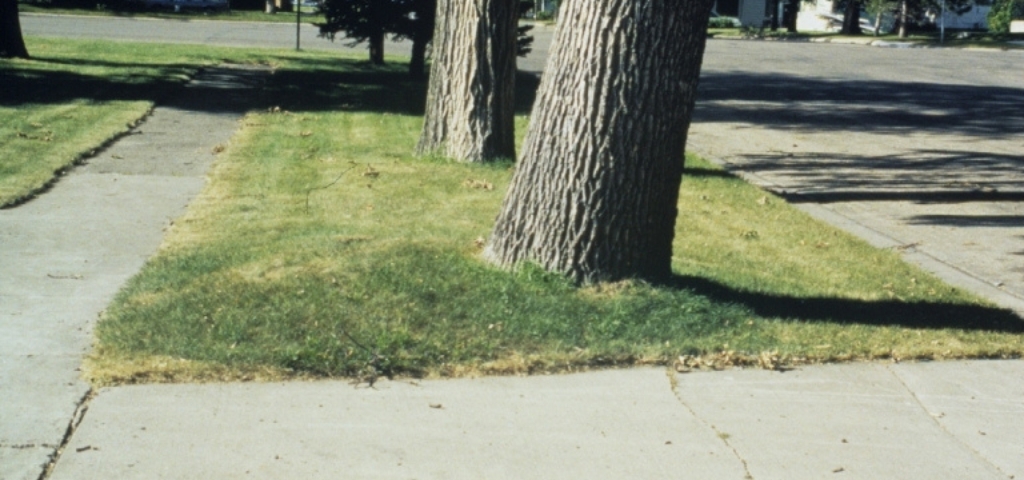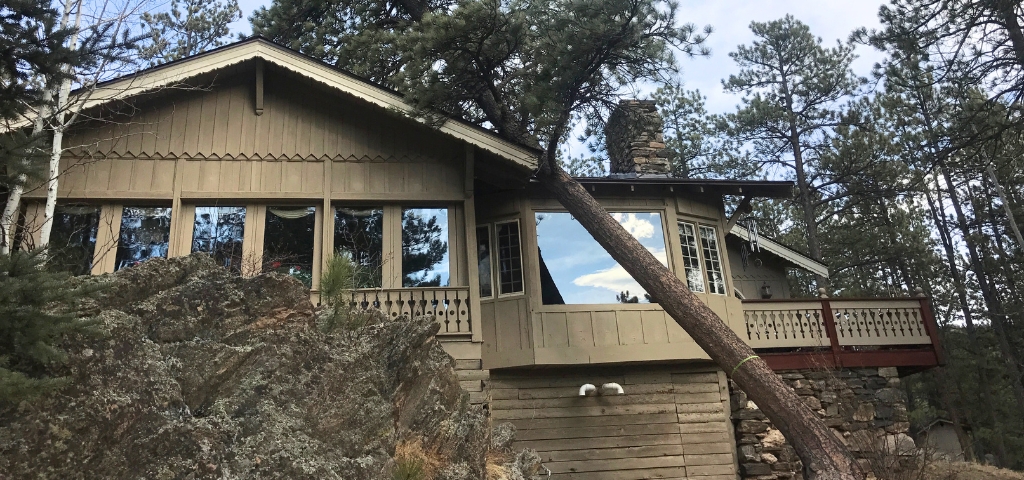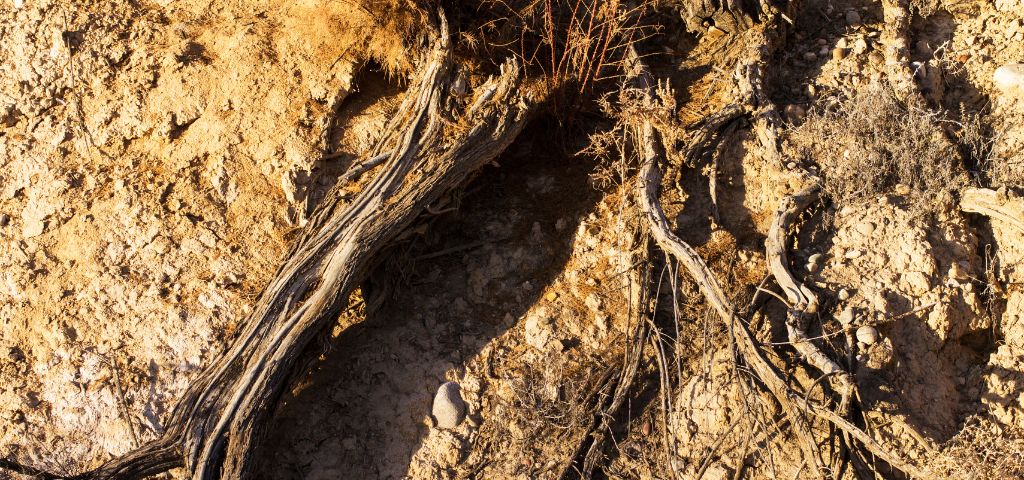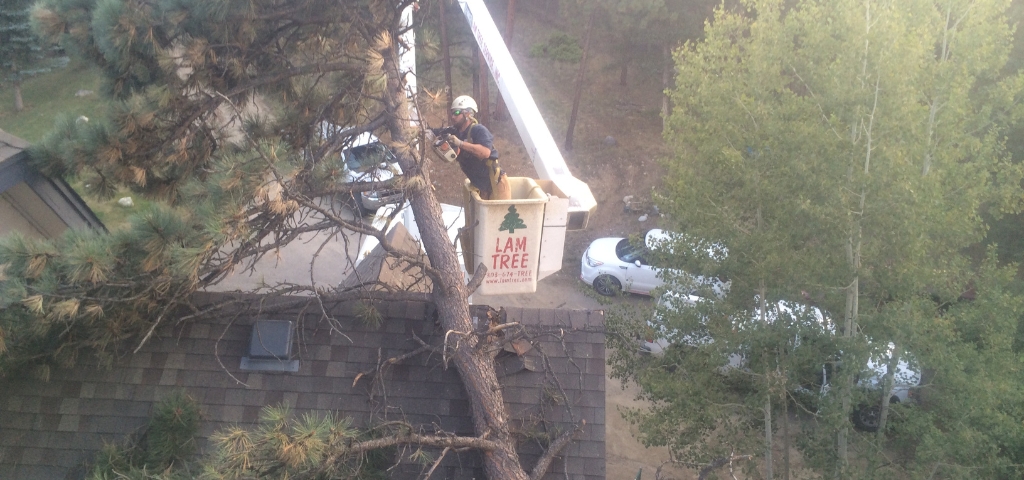Leaning trees could either be a problem in the not-so-distant future or completely harmless. Key indicators you can look for right now can help you determine whether or not you have a hazard on your hands.
In this article, we will help you determine whether your leaning tree can become a potential hazard. Keep reading to learn what issues to watch for.

Soil heaving and roots lifting, causing a tree to begin to tilt. Image courtesy of Peter Bedker, Bugwood.org.
Check The Ground Near Your Tree
Your first indicator is the soil around your tree. It shows signs of stress, trees weakened by extreme winds, and if your tree is at risk of uprooting entirely. Look for:
- Cracks: Even subtle cracks in the soil around your tree aren’t good. This can result from strong winds forcing the tree in one direction, resulting in uprooting (and this is just the first sign of it).
- Fungi: Not all fungi growing around your tree are dangerous. When fungi grow on your exposed tree roots or on the trunk of your tree is when you have a problem on your hands. This shows that the tree is dying, which will weaken the roots over time.
- Heaving Soil: Soil shouldn’t rise around your tree. Heaving soil can be a sign of uprooting as a result of root damage, rot, or excessive wind force pushing the tree in one direction.
If you have clay soil around your tree, you should know that it can retain excessive moisture. This can cause the ground to swell around your tree and be the cause of uprooting.
Clay soil makes it difficult for a tree to create strong, far-stretching roots. This environment may be suitable enough for a tree to grow, but as it reaches maturity, it may begin to encounter problems and lean.
Notice if Your Tree is Leaning Away From a Nearby Building
When trees are planted close to buildings, they often lean away from them. This is noticeable but generally not a cause for concern. If your tree slowly leans in the opposite direction of the building in question, it’s completely natural.
While trees grow, they avoid obstacles that block sunlight. Even if the angle of the lean seems extreme, it may not be a cause for concern. You’ll need the help of a Certified Arborist to determine if the leaning tree can become hazardous.
Leans that happen slowly over time aren’t a big cause for concern. When a tree leans suddenly, you’re more likely to have a problem on your hands.
Check the Angle of the Lean
Trees can lean more than you think before it becomes a cause for concern. The more a tree leans, the higher the chance of failure becomes, but it isn’t until it reaches near or passes 45 degrees of lean that it has a high likelihood of failure.
Please schedule a risk assessment before it reaches this angle. We can determine which type of lean it is, if it poses a risk, and track the angle of the lean to see if it increases.
Identify Trunk Health
Tree trunks are meant to be sturdy and withstand some amount of natural damage, such as tiny cracks in the bark. When cracks in the bark are vertical, spread far, or continue to spread, that’s a sign of a dying tree trunk. Look for:
- Dry, Crumbling Bark: While bark may normally seem dry, it has plenty of moisture just below the surface, in the cambium layer. When bark dries out and crumbles, it indicates a much larger problem.
- Missing Bark: If the tree has missing patches of bark along the trunk, it shows that there’s been a problem for quite some time. Healthy trees grow new bark, so when new bark ceases to grow, it shows the tree is dying. Eventually, it will decay to the point of falling.
- Fungi Growth: Fungi around your tree isn’t inherently bad. When it grows on the trunk or out of a vertical crack, that indicates that your tree may be dying.
Inspect Roots to See if They’re Damaged or Dead
Many tree roots are close to the surface, while others (known as “sinker roots”) dive much deeper into the ground. Your next step is to assess the health of any visible tree roots you have access to without moving or removing soil around the tree.
Touch any above-ground roots near the tree. If they’re soft to the touch and visibly dark brown, they could be oversaturated with water to the point of suffocation.
Dead roots are brown beneath their bark. Since your tree is leaning and it’s not advised to damage the bark to see beneath it, it’s best left to a Certified Arborist to determine whether or not your tree roots are dead.
Check For Dead Branches or A Lack of Foliage
Similarly to trunk health, you can spot signs of damage in the tree canopy. Look for:
- Branch Dieback occurs when twigs and full branches begin to die from the tip and work down the rest of the limb. If you’ve noticed lots of twigs and dead branches naturally falling from your tree, it could be suffering from branch dieback.
- Thinning Canopy: You look up, and the canopy of your tree has empty spots where leaves or needles usually are. Save for seasonal changes that may impact foliage, this is a bad sign.
Perform a Risk Assessment
With this new information, it’s time to decide whether or not your leaning tree poses a risk to your safety. Using the information we’ve outlined here, you should have a good idea of your apparent risk.
We know it’s difficult to check and feel confident with your findings. Even if after reading this, you think your leaning tree isn’t likely to be a problem, it’s better to be safe than sorry. Having a certified arborist inspect your leaning trees will tell you:
- Any apparent risks to your safety
- Whether or not the lean is truly a problem
- Your next steps to secure or remove your tree
Your Next Move for a Leaning Tree
You’ve reviewed all the guidelines on this list, and it’s clear: your tree needs to be assessed by the professional arborists at LAM Tree. We’re ready to help.
We’ll run a risk assessment and deliberate if your tree needs to be removed or not. Just contact us to get started.






